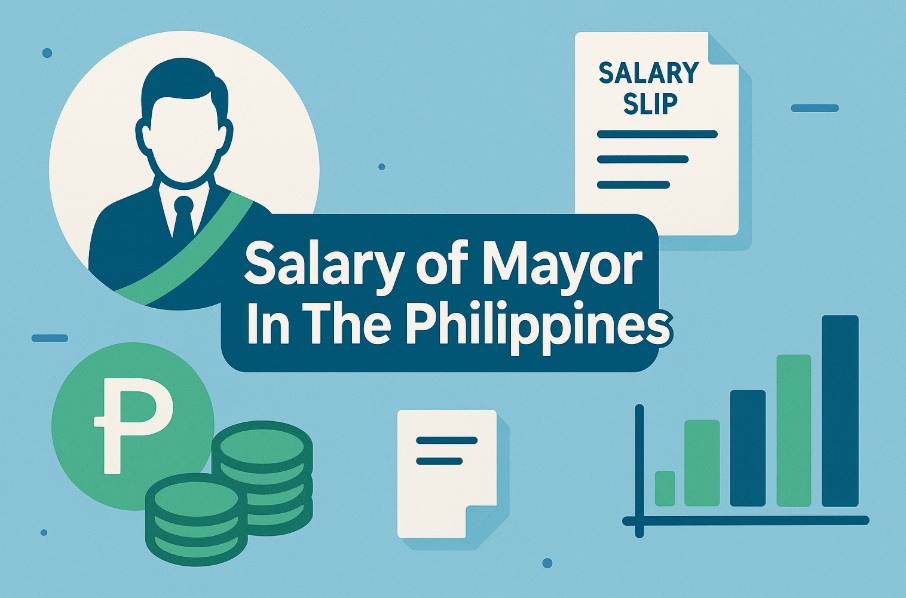Salary of Mayor In The Philippines
Knowing the salary of mayor in the Philippines is important if you want to understand how local government leaders are compensated for their responsibilities. Mayors are tasked with managing city or municipal budgets, leading development projects, ensuring public services, and enforcing laws within their area of jurisdiction. Because of these heavy responsibilities, their salaries are determined by law under the Salary Standardization Law (SSL) and vary depending on the classification of the city or municipality.
This guide explains exactly how much a mayor earns in 2025, including monthly salary ranges, allowances, benefits, and comparisons with other government officials, so you’ll have a clear picture of their compensation.
How Much is the Salary of a Mayor in the Philippines?
The salary of a mayor in the Philippines depends on three main factors:
-
Salary Grade (SG) – based on the Salary Standardization Law (SSL).
-
Income classification of the city or municipality (1st class, 2nd class, etc.).
-
Years of implementation under SSL V (2020–2023, fully implemented by 2023 onwards).

Salary Grade for Mayors
-
Municipal Mayors: Salary Grade 30
-
City Mayors: Salary Grade 30
-
Highly Urbanized City (HUC) Mayors / Metropolitan Mayors: Salary Grade 30–31 (depending on classification)
Salary Range (as of 2025, SSL V fully implemented)
| Position | Salary Grade | Monthly Salary (PHP) |
|---|---|---|
| Mayor (Municipality) | SG 30 | ₱185,695 – ₱207,978 |
| Mayor (Component City) | SG 30 | ₱185,695 – ₱207,978 |
| Mayor (Highly Urbanized City / Metro Manila LGU) | SG 31 | ₱217,144 – ₱246,267 |
That means a municipal mayor in a small town may earn around ₱185K per month, while a mayor of a highly urbanized city like Manila, Quezon City, or Cebu City can earn up to ₱246K per month.
Additional Benefits and Allowances of a Mayor
Aside from the basic salary, mayors also receive allowances and benefits, which can vary depending on the city’s income class.
Common Allowances and Perks
-
Representation and Transportation Allowance (RATA): May reach up to ₱15,000–₱50,000 monthly.
-
Personnel Economic Relief Allowance (PERA): ₱2,000 per month.
-
Hazard Pay (if applicable): Usually for those in high-risk or disaster-prone areas.
-
Mid-year and Year-end Bonuses: Equivalent to one month basic pay each.
-
Clothing and Uniform Allowance: Around ₱6,000 per year.
-
Performance-Based Bonus (PBB): Depending on LGU performance.
In short, a mayor’s total monthly compensation can be much higher than the base salary when allowances and bonuses are included.
Factors That Affect a Mayor’s Salary
1. Income Classification of LGUs
-
1st Class Municipalities and Cities usually have more budget and therefore higher mayoral compensation.
-
Smaller towns (4th–6th class municipalities) stick with the lower end of the salary grade range.
2. Geographic Location
-
Metro Manila mayors tend to have higher salaries and allowances than their provincial counterparts.
3. Length of Service and Step Increments
-
Within a salary grade, a mayor’s pay increases in “steps” based on tenure and performance.
Salary Comparison: Mayor vs Other Government Officials
| Position | Salary Grade | Monthly Salary (PHP) |
|---|---|---|
| Barangay Captain | Honorarium | ₱15,000–₱30,000 (varies) |
| Municipal Mayor | SG 30 | ₱185,695 – ₱207,978 |
| City Mayor | SG 30 | ₱185,695 – ₱207,978 |
| HUC Mayor (Metro City) | SG 31 | ₱217,144 – ₱246,267 |
| Governor | SG 31 | ₱217,144 – ₱246,267 |
| Senator | Special Pay | ~₱273,278 + allowances |
| President of the Philippines | SG 33 | ₱442,000 – ₱500,000+ |
As you can see, a mayor’s salary is comparable to that of a governor and not far behind national lawmakers, highlighting the significance of their role.
Why Do Mayors in the Philippines Earn This Much?
You may wonder why a mayor’s salary is relatively high compared to average Filipino workers. The reasons are:
-
High responsibility: They manage city budgets running into billions of pesos.
-
Public accountability: They are in charge of implementing national laws locally.
-
Risk and exposure: Mayors face high political risks and even security threats.
-
Retention of qualified leaders: Competitive salaries attract capable leaders to serve in government rather than moving to private sector jobs.
Frequently Asked Questions
Do city mayors earn more than municipal mayors?
Not always. Both have Salary Grade 30, but highly urbanized city mayors fall under SG 31, which is higher.
Do mayors get bonuses in the Philippines?
Yes. Mayors receive mid-year and year-end bonuses equal to one month’s salary, plus performance-based incentives.
Who earns more: a mayor or a governor?
Generally, they earn about the same, since both positions are classified as SG 30–31, depending on the income class of their province or city.
How much does a Metro Manila mayor earn?
Mayors of highly urbanized cities in Metro Manila (like Manila, Quezon City, and Makati) earn up to ₱246,267 per month plus allowances.
Do mayors get retirement benefits?
Yes. Like other government officials, mayors are entitled to GSIS retirement, insurance benefits, and gratuity pay, depending on their years of service.
The salary of a mayor in the Philippines ranges from ₱185,000 to ₱246,000 per month in 2025, depending on the classification of their city or municipality. While this may sound high compared to the average Filipino worker’s wage, it reflects the weight of their responsibilities, from managing billions in public funds to leading local governance.






